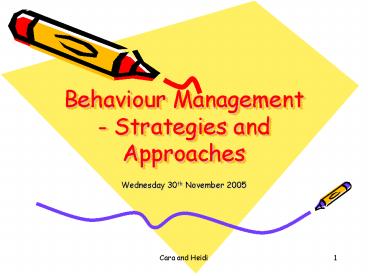Behaviour Management Strategies and Approaches - PowerPoint PPT Presentation
1 / 12
Title:
Behaviour Management Strategies and Approaches
Description:
Focuses on individual action plans - Establishment Phase - Self-esteem - Avoiding ... disruptive behaviours can be addressed even nipped in the bud by a non ... – PowerPoint PPT presentation
Number of Views:123
Avg rating:3.0/5.0
Title: Behaviour Management Strategies and Approaches
1
Behaviour Management - Strategies and Approaches
- Wednesday 30th November 2005
2
Introduction
- Focuses on individual action plans
- Establishment Phase
- Self-esteem - - Avoiding Confrontation
- Strategies in relation to a whole school approach
- Theory and Government Support
3
Establishment Phase
- The establishment phase of the year is a crucial
time in the development of a class group (and
even the school as a community) It is for the
teacher to explain how things will be this
particular year with regard to expectations about
behaviour and learning. (Rogers, 2002, p25)
4
Caras Strategies for Establishment Stage
- Visual Reminding
- Take photos of the children
- Working co-operatively
- Tidying the room
- Communicating respectively
- Sharing co-operatively
- and these photos are displayed with the
relevant rules the teacher has established. - - Give me 5
5
Heidis Strategies for Establishment Stage
- Discuss Hidden rules with the children
- use of rhetorical questions, eye gaze, a smile
and a nod of the head to indicate that it is all
right to answer, and very subtle rules which many
children find it difficult to learn - (McNamara Moreton 2001 P.64).
6
Heidis Strategies for Establishment Stage
- Example Lesson Plan handout
- (to be used in NQT Yr)
- Giving children the responsibility of helping
create the rules will - Help them remember the rules
- Help them understand the rules
- Increase their respect for the rules
7
Conflict Tensions
- If children have different teachers throughout
the day, children may be confused by the
different rules - SOLUTION
- Adopting a WSP and communicating effectively with
colleagues.
8
Avoiding Confrontation
- Using strategies effectively will lower the time
spent on correcting behaviour, and increase
teaching and learning time. - Strategies
- Take up time
- Involves giving a behavioural choice, a
task-focus and expectation of cooperation, - (Rogers 2002 P.7).
9
Avoiding confrontation
- Non-verbal communication many disruptive
behaviours can be addressed even nipped in the
bud by a non-verbal cue, (Rogers 2002 P.65). - Partial agreement
- Avoids a yes and no argument
10
Self esteem
- Tassoni (2000, p173) states, Having high
self-esteem allows us to fulfil our potential
Low self-esteem affects the choices that we
make, - Tension Low self esteem low motivation
- Strategies
- Because Game
11
Self esteem
- . Coopersmith found that of those who were
significant to pupils the peer group and the
teacher feedback were two thirds of the influence
in shaping self-esteem, whilst the parents
self-esteem was only one third. - (Cited in McNamara and Moreton, 2001, pg 19)
- The importance of working with parents
- Handout links to WSP Parents
12
Conclusion
- Ideas can differ due to age range and need to be
adjusted accordingly. - Strategies are personal to the teacher be
confident in your strategies. - Behaviour management is not textbook its a
learning curve learning through experience. - On school placement strategies can be developed.
Learning from each other!































